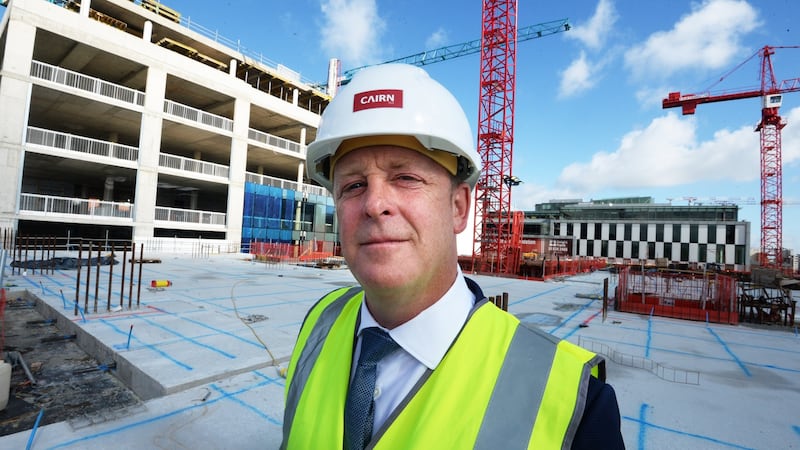Public Affairs Editor
Not many initiatives in the Government’s grand “Housing For All” plan to fix the housing crisis have sparked the firestorm that the Croí Cónaithe – “Living Heart” – (Cities) scheme has.
Where most State housing measures have aimed to improve affordability for home buyers, this scheme is uniquely aimed at improving what is effectively affordability for apartment builders.
The initiative, intended to increase the supply of housing in the five main cities, is aimed at helping builders construct apartments to sell to owner-occupiers by paying a subsidy to cover the shortfall between the sale price of apartments and the current higher cost of building them.
READ MORE
The problem arises from the fact that the current cost of building apartments outstrips what developers could sell them for on the market – the “viability gap” that the Minister for Housing Darragh O’Brien is trying to plug with Croí Cónaithe (Cities). Put simply, building apartments for owner-occupiers would be, right now, a loss-making business and this is reflected in the fact that few, if any, are being built.

It is a different story for apartment blocks built for the build-to-rent sector, where investors and developers can easily cover the cost of the development from exorbitant monthly rents where purpose-built buildings for the rental market are leased out en masse to tenants.
Any scheme that is designed to tackle the country’s housing emergency by putting taxpayer money directly into the pockets of developers will stir naturally controversy.
It is not surprising that this new plan has kicked a hornet’s nest, evoking the wild tax incentives of the Celtic Tiger era that helped send that property boom into the stratosphere.
Unusually, the criticism has come from all sides. As Trinity College Dublin economics professor Ronan Lyons pointed out in a column for The Currency this week, Croí Cónaithe has become “an ideological Rorschach test” where “everyone sees what they want from it – typically in terms of what’s wrong with the housing system right now”.
‘Daylight robbery’
Social Democrats housing spokesman Cian O’Callaghan has called it “an act of daylight robbery – taking from the people and giving to developers”, while Sinn Féin’s housing spokesman Eoin Ó Broin called it “the craziest housing scheme that any minister for housing has brought before us” during his six years as a TD.

Housing policy analyst Lorcan Sirr, a lecturer at Technology University Dublin, called it “poorly thought out” and has argued that the viability issue could be resolved instead by building affordable houses, which buyers prefer, at a much cheaper cost and at similar densities on city sites without having to build upwards, where costs rise with the floors.
Some in the building sector aren’t keen on it either.
Tom Parlon, director general of the Construction Industry Federation, said the scheme was a “bonanza for commentators” who brand it a “windfall for developers”. He said the gap between delivery costs and what developers would be paid for the apartments was “all up in the air” given that the subsidy would only be paid once the block was complete at some point in the future.

Cork developer Michael O’Flynn believes that the concept behind the scheme is good in setting out a plan for “brownfield” sites in cities but believes the State’s financial commitment must come up front if builders are to secure finance for “speculative” projects planned “so far in advance”.

He believes the Government is “paranoid” about any perception of money going to a developer, even when an owner-occupier is the ultimate end beneficiary.
“Why is it confined to an end-user? Because it is a politically driven subsidy to help the purchaser and not the developer. Well, guess what: if you don’t help the developer, you won’t get product for the purchaser, so it is completely misconceived,” he told The Irish Times.
Where almost everyone appears to agree is that there is a problem. Constructing apartments for owner-occupiers is not financially viable, particularly since the surge in the cost of materials due to supply chain disruptions caused by Covid-19 and then Russia’s invasion of Ukraine.
Kick-start
The motivation behind the Department of Housing in establishing the Croí Cónaithe scheme is to kick-start building on some of the tens of thousands of apartments for owner-occupiers, for which planning permission has been granted, but where no construction work has yet started.
Central Statistics Office figures show almost 70,000 apartments have been granted planning permission over the past three years, including about 40,000 in Dublin – the equivalent of four years of housing supply in the capital. Industry sources say building work has started on about a fifth of these apartments but almost all are build-to-rent apartment blocks.

The Society of Chartered Surveyors in Ireland estimated in a report last year that a typical apartment in a block of five to eight floors costs between €435,000 and €520,000 to build, excluding VAT. In the more expensive parts of Dublin, open-market prices might exceed these construction costs but in most places they don’t and the viability gap is stark, at upwards of €70,000 to €90,000 per apartment. The SCSI report is based on 2020 prices, so the gap is likely even larger now.
This is where the department is stepping in. It is willing to offer a subsidy of up to €120,000 per apartment to cover that gap in the hope that it will activate idle planning permissions in Dublin, Cork, Limerick, Galway and Waterford. Where the viability gap is bigger outside Dublin because sales prices are lower, the scheme will offer 20 per cent more, or up to €144,000 per apartment.
The department hopes the €450 million being pumped into the scheme will cut the cost of building up to 5,000 apartments, which in itself is a fraction of the 300,000 homes promised under “Housing For All” by 2030. There are strict pre-qualifying criteria applying to developers: as well as being located in the five cities, their apartment developments must be four storeys or higher, comprise at least 35 dwellings per hectare and a minimum of 40 apartments, and be close to public transport. Building must start by next March and be completed by the end of 2025.
Full planning must have been granted and building work must not have started yet, though apartment blocks in multi-phased developments where other phases have started are eligible.
The per-apartment subsidiary is paid to the developer only on the closing of the sale to an owner-occupier. To qualify in advance, developers undergo detailed due diligence, including an “open-book assessment” showing delivery costs and potential sales, with the department’s own outside advisers and the Housing Agency running the rule over the developer’s figures.
Information documents illustrating how the scheme will work show a three-bed apartment costing €450,000 with an anticipated subsidy of €115,000 or 20 per cent of the overall €565,000 cost.
This would mean a household would require an income of more than €100,000 to participate. According to the CSO, just 14 per cent of households earn this amount.
Supply increase
The department sees the scheme as a measure to increase supply, not as an affordability scheme for buyers, although buyers can use the various affordability supports such as the Help to Buy and First Home Affordable Purchase Shared Equity Scheme to purchase them. This has led some to question why Croí Cónaithe should have any part in a “Housing For All” plan.
“Why would you subsidise non-affordable supply for people on the highest incomes? That doesn’t make any sense,” said Mr O’Callaghan of the Social Democrats.
In a measure aimed at protecting the State’s subsidy from buyers “flipping” apartments, a clawback clause allows the department to recover a share of any profits – equal in proportion to the subsidy paid for the apartment – should the apartment buyer sell it on within 10 years.
Where things get tricky, particularly for political reasons on a taxpayer-subsidised scheme, is the profit going to the developer. The department is working off the industry norm of a 15 per cent profit margin, justifying this on the basis that the State is making no guarantee to the developer that there will be a buyer once the apartments are built or that they will get the subsidy.
In other words, the development’s view is that the developer needs to be paid a profit for this risk they are carrying. For more complex apartment blocks, there is even a possibility that the margin could be higher than 15 per cent.
For Michael O’Flynn, the risk expected of developers means the scheme won’t work.
“The two ends don’t meet. You are funding unviable development, which the subsidy makes viable, but it will only make it viable if you have a purchaser at the end,” he said.
It could take 18 months to two years to build the apartment block and without any forward commitment that the subsidy will be there, projects won’t go from unviable to viable, he says.
“I cannot understand how people have not thought this out fully,” he said.
Taking a punt
Others are willing to take a punt. Michael Stanley, chief executive of Cairn Homes, one of the country’s most prolific apartment-block developers in recent years, said his company would submit a proposal before the department’s expression of interest deadline on June 21st.

“It is complex. It requires a lot of pre-qualification but it is a starting point. What it recognises is that there is roughly a €100,000 gap between the cost of delivering something and what somebody could afford to pay for it,” he said.
Mr Stanley acknowledges it would be difficult for the Government to justify, without proper checks, pre-funding developments with taxpayers’ money to commence building work.
“I would love to see something more simple and straightforward, but housebuilders saying the Government should just simply write more cheques to builders and not have any proof that they are getting value is naive,” he said.
He argues, more generally, for a rebalancing of construction in cities and thinks the “Living Heart” scheme will help. He says the disproportionate amount of office building compared to apartment building has created lots of places to work in cities but not enough places to live in.
“If we keep building offices at a ratio of 10 to one to residential accommodation, how can we create sustainable cities in the future?” he said.













